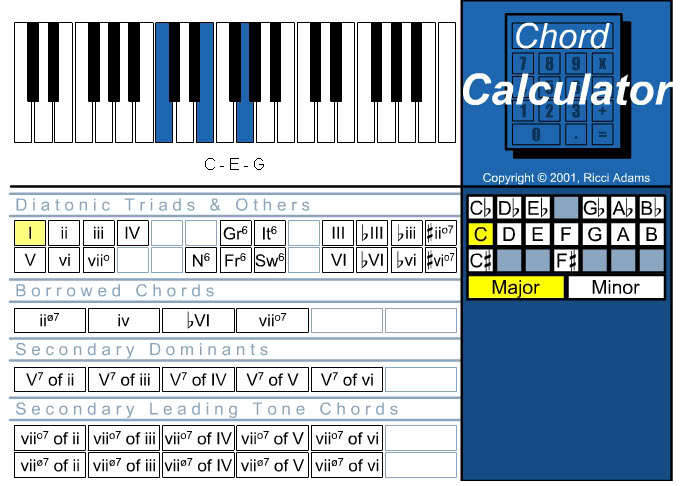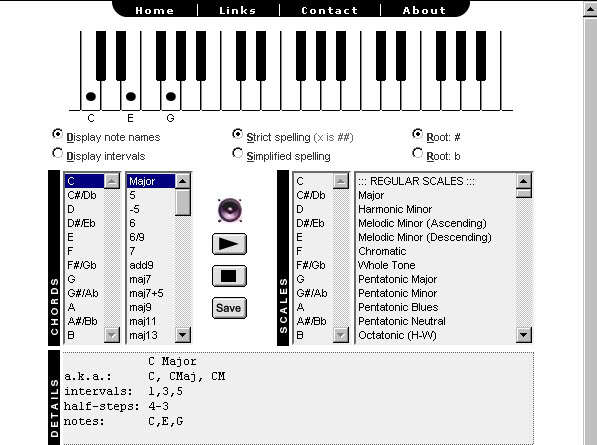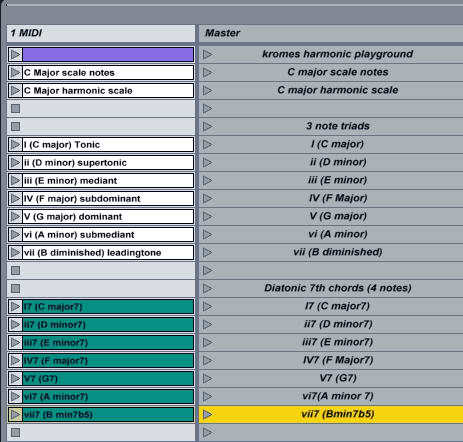Hi guys in a previous post I mentioned I was working on an Ableton project.
I like to think of it as an harmonic scratch pad in c major.
A bit like a poor mans improvisator but it has one advantage in that it prints the real chord names to abletons arrangement page.
Quite useful for beginners then. (i hope)
*****************
Chordwise the project currently contains the following chords all built from the C major scale.
3 note Triads:
C Major
D Minor
E Minor
F Major
G Major
A Minor
B Diminished
Four note Chords:
C Major7
D Minor7
E Minor7
F Major7
G7
A Minor7
B Min7b5
I’ve also included some other chords that add a bit of variety.
Some may sound very weird unless used in the correct context.
For example say you are playing the c major chord over 4 bars and it sounds a bit
dull you could spice up the sequence with a Csus2 chord or a Csus4 or both.
Suspended Chords (think of these as tension chords neither Major or Minor)
C Sus2
D Sus2
F Sus2
G Sus2
A Sus2
C Sus4
D Sus4
E Sus4
G Sus4
A Sus4
Sixth Chords:
C6
F6
G6
Sixth Suspended:
C6 Sus4
D6 Sus4
G6 Sus4
Seventh Suspended:
D7 Sus4
E7 Sus4
G7 Sus4
Min6:
D min6
Power Chords:Neither major or minor since the 3rd isn’t included these are great chords to hide the identity of the true key of your tune until you are ready to let rip. ![]()
C5
D5
E5
F5
G5
A5
I think this project would be of use for anyone just starting out wishing to
avoid the anxiety of hitting wrong notes or chords when making tunes
because put simply all of the chords work within the C major scale.
As long as you just play your melodies on the white notes its pretty
much hard to go wrong. Its not genre specific either.
To get the most out of the project a little backround theory is an advantage
but not essential. With that in mind I’d highly reccomend you download the raven spiral informal kickass music theory guide.!!!
My own guide will go on hold for now until I complete it.
[url]http://www.monadtunes.com/ravenspiralguide.pdf[/url]
Chordcalc is one really sweet web based chord tool.Highly reccomened.

[url]Chord Calculator
Another excellent web based chord tool. Chordhouse has a huge database of piano chords and scales.

[url]http://www.looknohands.com/chordhouse/piano/[/url]
hey bro…its good stuff, but it would be great if you were able to talk to say what you were doing.
yes, nice effort man . I found a neat little program for beginners it defo helps some people to get use to clefs and stuff my older bro for one !
if you could talk through your vid like howard says that would be a lot clearer ![]()
heres a link…www.jaydemusica.com ![]()
Cheers guys,
I doubt i’ll add naration anytime soon having said that the project itself has a lot of info within it that the youtube clip doesn’t show and the project will be uploaded here soon.
I’ll keep coming back to this thread and fill in the huge holes in the theory but it has to start somewhere and that somewhere is here ![]()
thats really cool bro, will you be uploading this project to a user section if we ever get one???
Good effort but I don’t really understand what it is… to me it seems like a bunch of random scales and stuff. I’ve no doubts it’s very good but I’m a music newbie so it’s tough to work it out. Commentary would be awesome. I love that there’s user content coming out here, this board is become very very cool.
[quote]bouffont (10/12/2009)[hr]Good effort but I don’t really understand what it is… to me it seems like a bunch of random scales and stuff. I’ve no doubts it’s very good but I’m a music newbie so it’s tough to work it out. Commentary would be awesome. I love that there’s user content coming out here, this board is become very very cool.[/quote]
Yeah I can see why it looks like a random bunch of scales.
But in reality there’s nothing random about the chords included.
If you forget all the 4 note chords, suspended, sixths etc all thats left is the major, minor and diminished 3 note triads as listed below which are all built from the C major scale.
Notice that all of the chords below share the same scale notes of the C major scale.
ex C,D,E,F,G,A,B
Since all of the chords below contain only white notes built from the C major scale its a fair bet they should sound coherent. Especially if you play them in a logical way. Played completly randomly they would still sound ok though.
The notes in brackets are actually the chord notes themselves.
C Major (c,e,g)
D Minor (d,f,a)
E Minor (e,g,b)
F Major (f,a,c)
G Major (g,b,d)
A Minor (a,c,e)
B Diminished (b,d,f)
Not a black note in sight to clash with when playing a melody over the top of those chords.
If you get 5 minutes free sit at your keyboard and play the c major chord with your left hand (c,e,g)
with your right start hitting any white note and it should sound okish.
Well the same holds true for all the chords above.
I understand why commentary would be an advantage but since my bike
accident in which my jaw was completely smashed to bits ![]() I doubt you’d understand a word i would be saying lol.
I doubt you’d understand a word i would be saying lol.
@jon
i doubt i’ll wait until the user section is sorted and just upload the project sometime tomorrow.![]()
As promised here is the beta version of the Ableton project I’ve been working on.
A few pointers:
The screenshot below shows the heart of the project.

The C major chord cell groups.
All other chords are related to the C major scale in some way
and are either embellishments or extensions.
Some may say some of the chords I’ve included don’t qualify for inclusion in the C major scale and I take that point , some don’t obey the strict
rules of harmony but this is a playground so some rules have been stretched.
If you don’t like it …you know what I mean. lol
You’ll notice I’ve included roman numeral labels with each chord to make it easier
to experiment with chord progressions you may see around the net.
I’ve also supplied the functions of each of the important chords. ex C major (Tonic)
[url]http://en.wikipedia.org/wiki/Tonic_(music)[/url]
Here’s a few example of how it works.
I’ll start with an example of an overused progression.
I IV V .Thousands upon thousands of rock song progressions have used this as a basis for composition. Especially Rock proving that there’s no way to copyright a chord progression. ![]()
In the above example you’d just hit the:
C major cell
then the F major cell
followed by the G major cell.
And there you have it you’ve just played the classic I - IV - V progression in the key of C Major.
Here’s another.
I vi IV V …Every Breath You Take by The Police.
C major - A minor - F major - G major. (in the key of C major)
And another.
I V vi iii IV I IV V
This is the progression used in the (in)famous Pachelbel’s Canon in D, which in itself is possibly the most overplayed piece of classical music.
Since my harmonic playground at present only deals with the key of C major
the piece would be in the key of C but the sequence itself is correct and would therefore sound ok.
Yep this is a current limitation of the harmonic playground but there’s nothing stopping you if you so wish transposing the completed sequence up to D major.
The same could be said of all the chord progressions above and below.
Transposition may be necessary.
Just a reminder this project is for beginners who want and need a start point
to progress beyond but it can still be fun especially if you hit a creative brick wall and cant afford the likes of Improvisator or get your head around the other really cool plugins.
If there’s interest I’ll update the project to cover all 12 keys making it possible
to play the progressions in their original keys.
Obviously that would open up the potential to jump between keys but I’d keep it limited to just basic harmonic chords otherwise the ableton project would require an aweful lot of scrolling :D. Besides as I’ve mentioned there’s already some top quality tools that go far beyond the basic preset chord cell method I could make.
Just to put this all in perspective sometimes less is more so don’t be deceived by thinking that just a few chords won’t cut the mustard in composition.
Watch this clip which shows just how far just four chords can go ![]()
I V vi IV
In the key of C major
C Major G major A minor F major.
Even a **** load of trance tunes have made it bigtime with just a few chords but i’ll let you discover the various sequences. Just starting hitting the cells and experiment.
Finally.
One thing that I like about this project from a tutorial point of view is the visual aspect. You can record any sequences to the arrange page and you’ll see the chord names and roman numerals represented and hear a good combo and think why does that V7 sound so sweet when I return to the I chord. Once you start seeing and hearing those kind of cadences you’ll soon know when and where they can work within your own music.
And remember hit the white keys when soloing over the chords and really you can’t go wrong. It may not be good music but its music.
oh and if you choose an arp pattern in your chosen synth be sure to realise
that its highly likely there will be non chord tones within it.
But if they sound cool who gives a ****? ![]()
For best results start with the I chord (c major) and start your melody with C then pick another chord but every now and again come back home to the I chord and bring your melody note back to C this reinforces c major as the home key otherwise you could drift into another mode like dorian which also uses the white notes without realising. Not a bad thing but your tune could start sounding really random.
If anyone wants to make a basic tutorial with commentary be my guest.
I am sure it would help.
Anyway enough talk here’s the Ableton Live project files.
[b]Ableton 7&8 Harmonic Playground v2 [url]http://www.sendspace.com/file/jsu1sl[/url][/b]
Please let me know what you think and if you have any questions don’t hesitate
to post here I am more than happy to help.
ps. If you find any errors and lets face it there’s bound to be a few please let me know so I may correct them. Suggestions for improvement are most welcome.
cheers.
Hey your project is really great !! I like the idea ![]()
PS : the ableton 8 project link doesn’t work , could you please re-up ?
thank you very much ! ![]()
cheers chneb,
I’ve just re-upped after making a few last second changes.
the new links should work shortly.
S.A mods can we sticky this?
^^^^^^ it’s the internet, wait till your wife’s outta the room and you can sticky anything you want :w00t:
[quote]mussi81 (10/16/2009)[hr]S.A mods can we sticky this?[/quote]
I am not sure its worthy but one thing i noticed is this thread got a lot of page views and to me that suggests a lot more people want to know about basic music theory.
Trouble is theory is hard to explain and I am not the best person to do this however I am sure a series of SA video’s would go down a storm.
In the meanwhile I’ve updated the thread with a few more screenshots of tools I’ve found that helped me a hell of a lot.
I am also working on a new simplified playground but this time I’ve chosen C minor scale as the home. I’ve also beefed up the chords a bit to make them sound fat which makes it really cool for trance progressions. Another addition: I’ve included the note names that go into each chord so when they get printed to the arrange page at a glance you can easily see not only the chords, the numerals but also what bass notes would sound ok with the chord all without ever having to expand the chord sequence cells. This speeds up workflow a lot.
When I get time i’ll upload a screenshot.
@jon lol
I fully agree guys, theory is a BIGGIE. It’s boring really, but so vital. I mean i have a small idea about from when i used to learn piano as a teen, but i’m not very good at chords and scales.
I’d really value so much something in depth and easy to follow and understand.
[quote]jon_fisher (10/16/2009)[hr]^^^^^^ it’s the internet, wait till your wife’s outta the room and you can sticky anything you want :w00t:[/quote]
lol! Thats another benefit of having a studio in your loft!